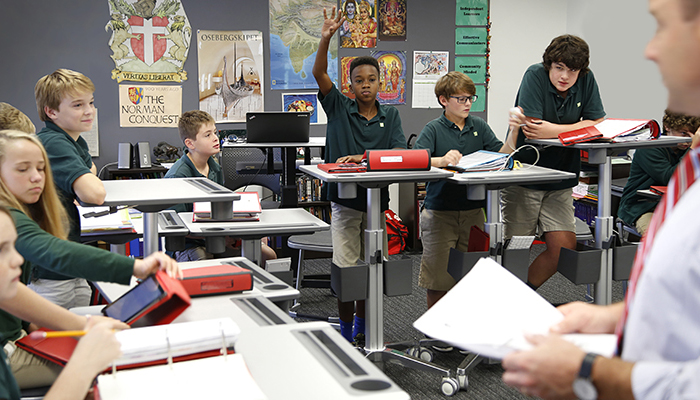Thank you to those who joined us for the Standing Desks: How and Why Educators Are Using Them webinar about how standing desks create a healthy, flexible, and personalized learning environment. (If you missed the webinar, access it online at edWeb and earn a CE credit!)
Bob Hill, education manager at Ergotron interviewed Monica Escobar, fifth-grade arts and history teacher, and Jim Girard, a seventh- and eighth-grade history teacher at Alexandria Day School in Virginia. They shared many insights gained from introducing standing desks to their students and unleashing the power of non-disruptive activity in the classroom.
Webinar listeners had an opportunity to pose questions on how to reduce student sedentary behavior and boost their academic performance. Bob Hill addresses three questions that weren’t answered during the session due to time constraints.
Q: ISN’T IT DISRUPTIVE TO HAVE SOME KIDS STANDING AND SOME SITTING?
A: This is a very common question among teachers and principals. Most are concerned about the impact of students standing and sitting at will during class, that they will lose control of the kids. The reality, as reported by teachers, is that these concerns become a moot point. The greater good of a more engaged student, more effective classroom dynamics and more classroom efficiency outweighs teachers’ initial concern.
Teacher Jim Girard explains: “I configure my classroom multiple ways throughout the day to allow for teacher centered instruction, group work, individual work and simulations. With the LearnFit® Desk, I can easily move set ups from a horseshoe shape, to multiple small groups and even all desks moved aside for an open floor space. Just one week into the first school year with the adjustable standing desks, I was already enjoying the benefits of giving the students the option to stand or sit at their desks.”
Q: WHAT’S THE COST OF A STUDENT STANDING DESK?
A: The basic desk/chair combo that has been used in education for generations ranges in cost from $150 to $250. These seated student desks inhibit student performance and health, and are not conducive to easy collaboration. Standing desks are priced from a low of $250 to $1,000, with fixed-height standing desks at the lower end. It’s useful for teachers and schools exploring sit-stand options to understand the restrictions of the various models available to them. Some standing desks may restrict individualized student adjustment and collaborative movement, and or are not scalable to multiple classrooms or whole schools. An adjustable, mobile option like the LearnFit standing desk ushers in a whole new era of classroom furniture. It allows students to intuitively adjust the height of the worksurface to suit them, and the casters allow for easy and natural movement for ultimate classroom collaboration.
Q: DO STANDING DESKS WORK FOR SPECIAL NEEDS STUDENTS?
A: Research at the ATTAIN Tech Lab in New Hope, MN, suggests it does. SPED students were encouraged to stand for at least five minutes every half hour. Simple movement may increase focus, concentration, work quality, and overall behavior for students with cerebral palsy, autism spectrum, developmental coordination, emotional and behavioral disorders. Watch a video of an interview with an ATTAIN educator or read the scientific journal article: Sit, Stand, Learn.
While Ergotron desks are not officially ADA-certified, educators find that both the LearnFit and TeachWell® mobile adjustable workstations help level the playing field for many students with physical challenges. For example, students in wheelchairs can wheel right up to the desk and engage more easily with peers while participating in group projects.
Stay tuned for more Q & A from the webinar, as well as other FAQ’s about active classroom furniture.
In the meantime, check out Ergotron’s educator resources for research on “sitting disease,” grants and funding sources, and other tools to support building the case for standing desks at your school.
You can also access last year’s School Moves! webinar on-demand – it focuses mainly on the metabolic health and engagement aspects of an active classroom. (CE credit is available.)



